And in this context I do mean stomping. First a brief explanation of the behavior, one I’ve seen multiple times with this species but have only rarely been able to photograph.
In winter Harriers often hunt voles in thick vegetation after the grasses have been packed down by snow so when the snow recedes the voles scurry around beneath the flattened grasses but almost never on top of them (for obvious reasons). Harriers hunt voles partially by sight and partially by sound by flying very low over the grasses.
When they see or hear a vole beneath them they pounce on it but there’s often packed grasses between their talons and the vole so they pounce again and again until the frightened vole in its panic allows them to get an actual grasp.
I call the repeated pouncing “stomping” because in the field that’s what it looks like to me. I tend to call the initial attempt “pouncing’ and the repeated attempts “stomping” but in my narrative below feel free to substitute “pouncing” for “stomping” if you prefer it. Based on what I’ve seen either one works reasonably well.
All photos are presented in the order they were taken.
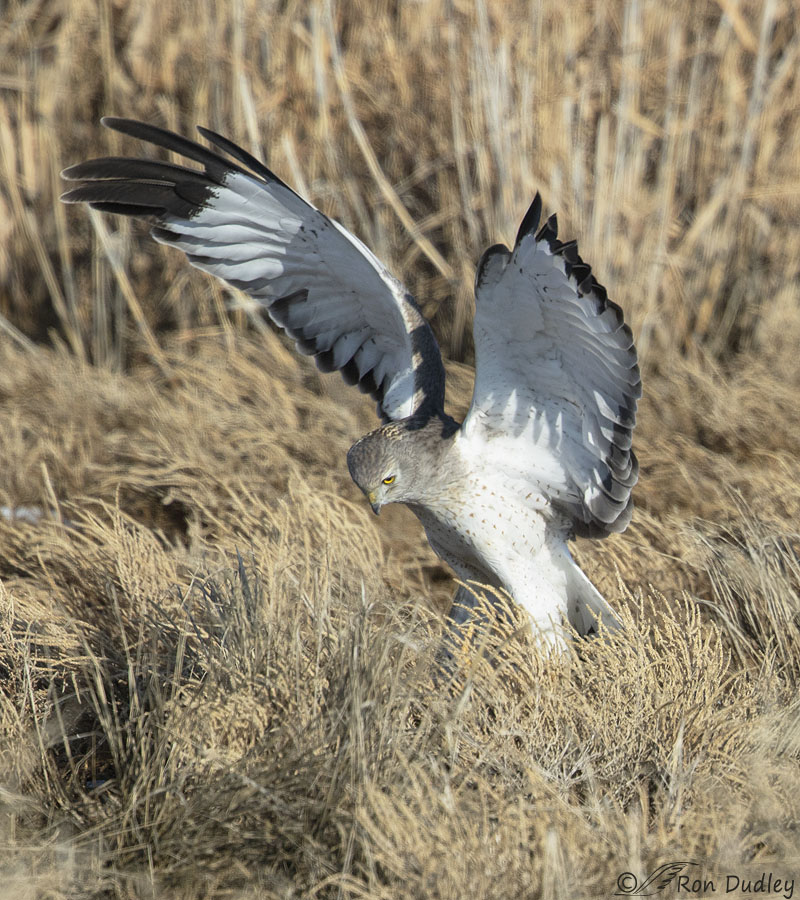
1/3200, f/6.3, ISO 500, Canon 7D Mark II, Canon EF 500mm f/4L IS II USM + EF 1.4 III Extender, not baited, set up or called in
Three days ago at Farmington Bay WMA I saw this male harrier begin his pouncing/stomping routine as I was driving down the road and still some distance from him. I didn’t want to miss the action as I was getting closer so in all of these photos except the last two I was firing my camera as I was driving slowly on the rough dirt road. Under these difficult circumstances relatively fast shutter speeds once again helped immensely with sharpness.
I’ve had some real adventures while driving and shooting at the same time on Farmington’s dirt roads!
Here the bird had already stomped a few times but he still didn’t have the vole in his talons so he…
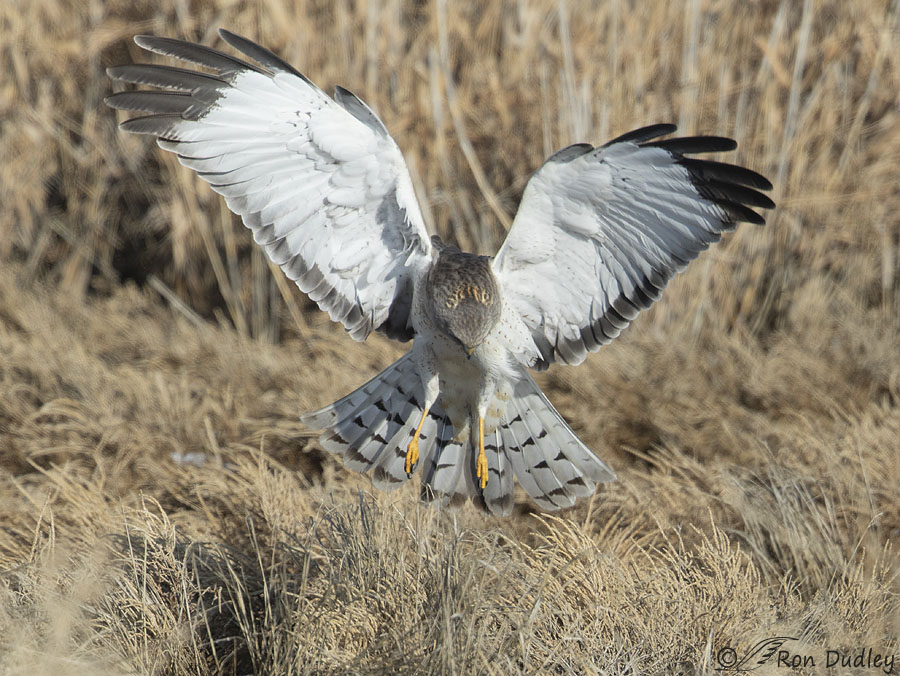
1/2000, f/6.3, ISO 500, Canon 7D Mark II, Canon EF 500mm f/4L IS II USM + EF 1.4 III Extender, not baited, set up or called in
stomped again. Repeatedly. He’d usually rise up to a height of a foot or two and then drop straight down stiff-legged on the vole beneath the grasses.
1/2000, f/6.3, ISO 500, Canon 7D Mark II, Canon EF 500mm f/4L IS II USM + EF 1.4 III Extender, not baited, set up or called in
This was a short hover as he was deciding precisely where to stomp.
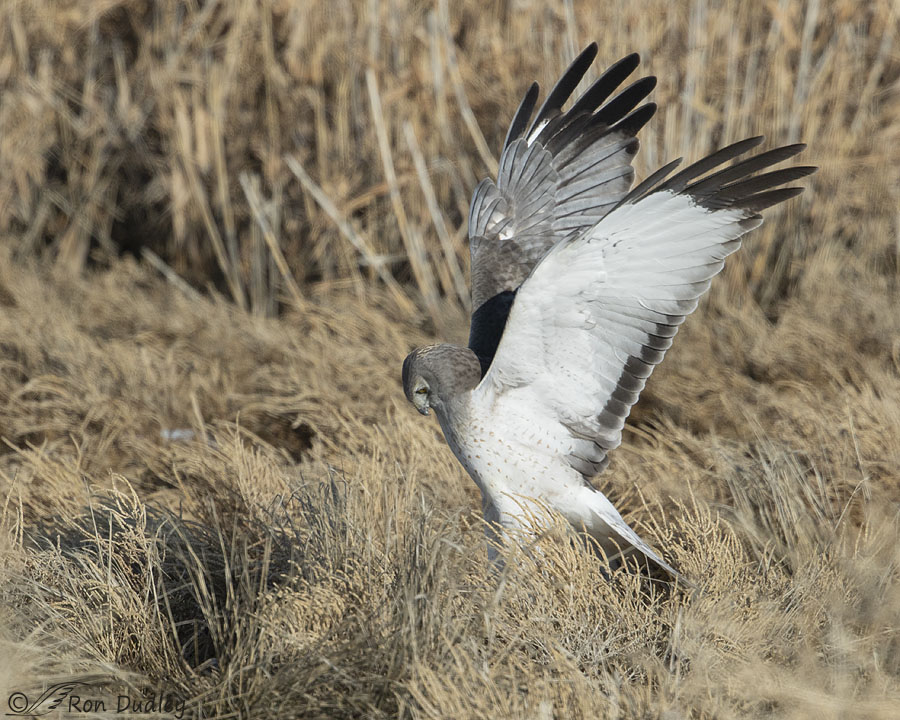
1/3200, f/6.3, ISO 500, Canon 7D Mark II, Canon EF 500mm f/4L IS II USM + EF 1.4 III Extender, not baited, set up or called in
The end of a stomp. At this point he probably didn’t know for sure if he had the vole securely or not.
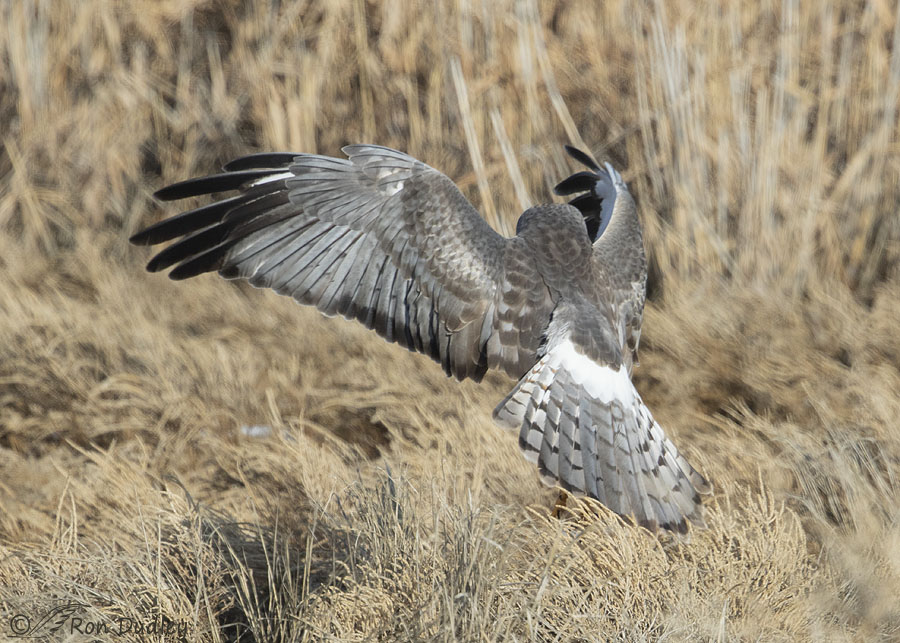
1/2500, f/6.3, ISO 500, Canon 7D Mark II, Canon EF 500mm f/4L IS II USM + EF 1.4 III Extender, not baited, set up or called in
He didn’t. The vole got away so he had to go after it again.
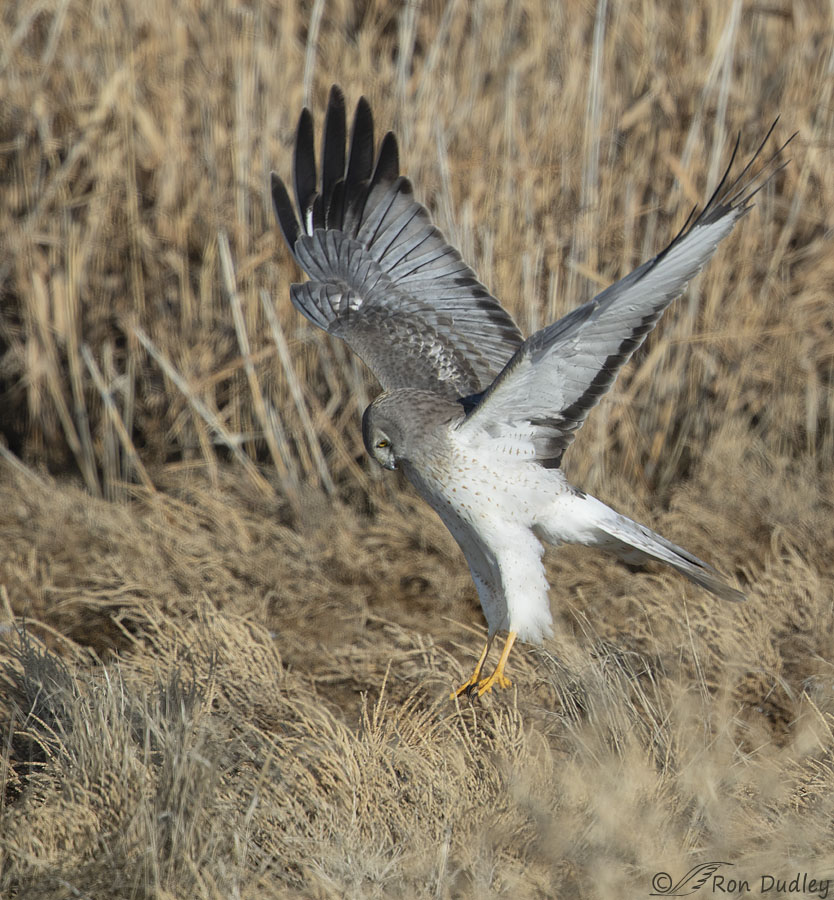
1/2000, f/6.3, ISO 500, Canon 7D Mark II, Canon EF 500mm f/4L IS II USM + EF 1.4 III Extender, not baited, set up or called in
Another stiff-legged stomp.
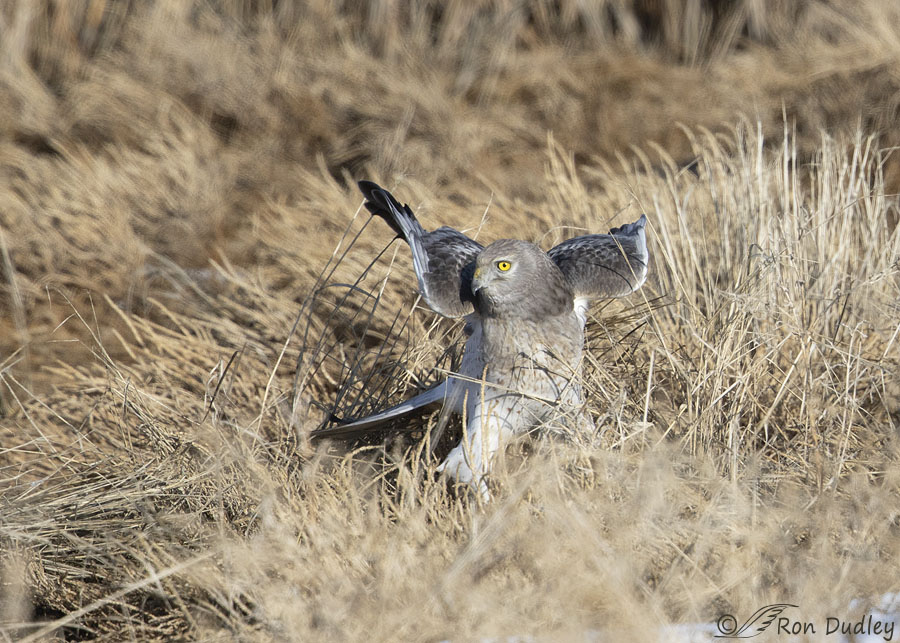
1/2500, f/6.3, ISO 500, Canon 7D Mark II, Canon EF 500mm f/4L IS II USM + EF 1.4 III Extender, not baited, set up or called in
A few seconds later he apparently thought he finally had the vole safely in his grasp so he folded his wings and began to relax a little. It seemed obvious to me that he really thought he finally had that little rascal.
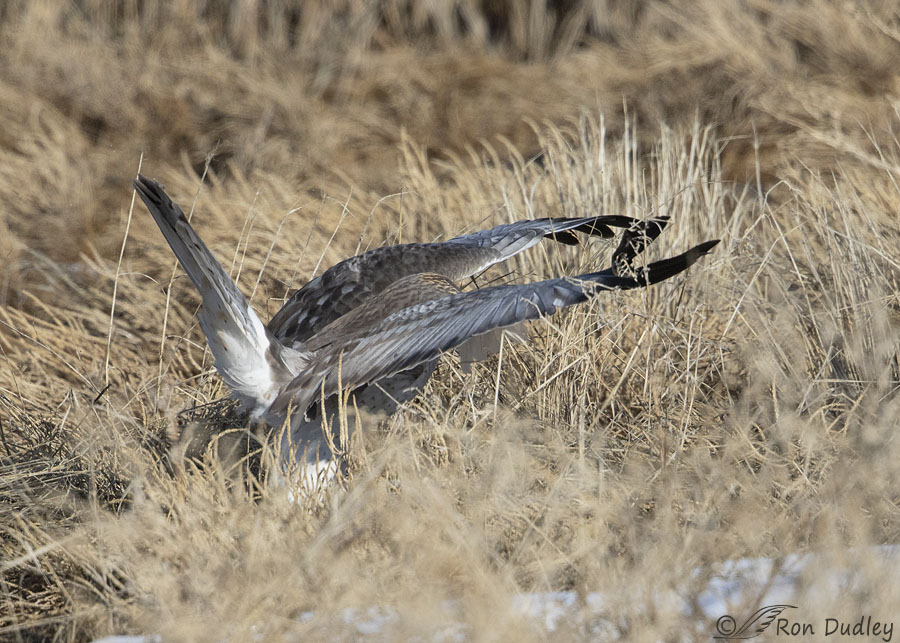
1/5000, f/6.3, ISO 500, Canon 7D Mark II, Canon EF 500mm f/4L IS II USM + EF 1.4 III Extender, not baited, set up or called in
But somehow the little bugger got away again and this was his reaction.
When he finally had the vole securely and permanently subdued he walked with it into the taller grasses so he could enjoy his meal in private.
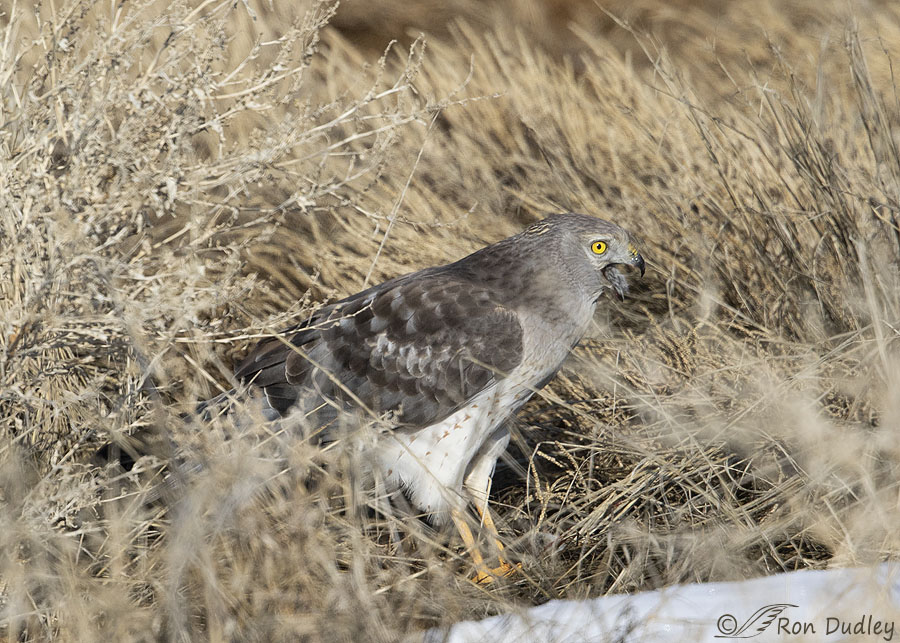
1/3200, f/6.3, ISO 500, Canon 7D Mark II, Canon EF 500mm f/4L IS II USM + EF 1.4 III Extender, not baited, set up or called in
I had to move my pickup again to get even this much of a look at him as he was gulping down pieces of his hard-won meal.
Interestingly, harriers are the only raptor species I’ve seen repeatedly perform this “stomping” behavior. I suspect it might be a function of their tendency to hunt extremely low over the terrain where they can use their facial disc to hear prey but not necessarily see it. So they often pounce on an imprecisely located sound instead of prey they can clearly see which results in extended stomping bouts before they can secure their victim.
At least that’s my working theory.
Ron


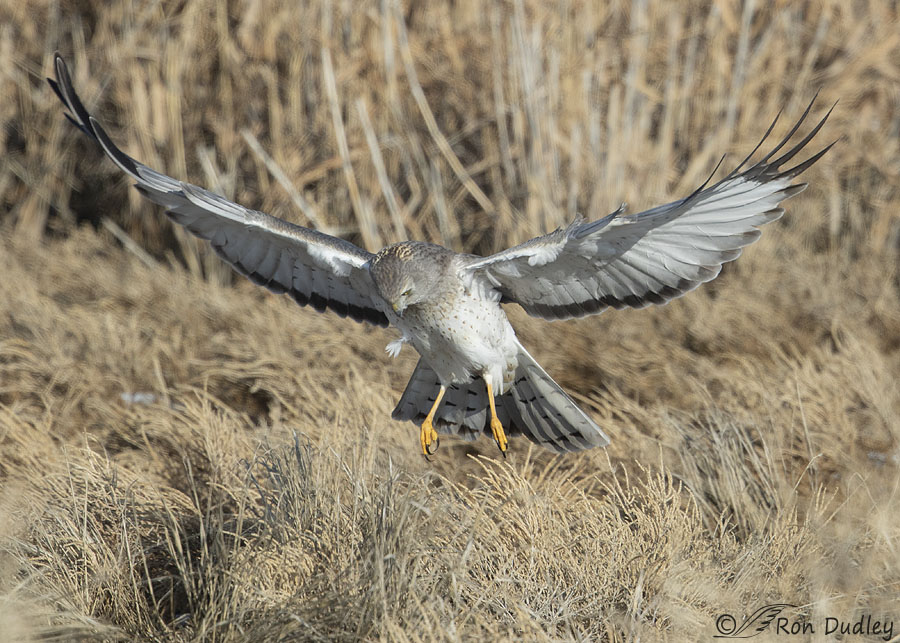
Simply sensational behavioral series Ron!
Charlotte
I see red-tailed hawks stomping after they don’t quite get voles in packed vegetation. They don’t lift off the ground though. They just stand, maybe move a little bit and stomp with they feet. When they use this tactic, I have not seen them ever capture the prey. It must work sometimes or they wouldn’t continue to do it as adults.
Pam, I’ve seen what you describe with Red-tails too.
Fantastic series!
Thanks, April.
Ron what a beautiful series. Glad we don’t have to go through that to put food on our plate.
I’ve been missing a few days due to challenging physical situations. I surely understand your dilemma in my own way. You help me be strong and not complain.
Thank you so much, Alice
Thanks, Alice. But as you know I’ve done my share of complaining. I wish you the best with your own challenges, big time.
As Kathy noted, the colors of the Harrier are beautiful. I’ve always only seen them on gray, overcast, and usually rainy days (yep, this is Washington). To see them in the sun is a revelation. I understand more clearly now why dark days are a frustration. Your series shows that no one can say he doesn’t work for his lunch.
Yes, he deserved that meal, Lyle. It was more of a workout for him than usual.
Chuck E Cheese has “Whack-a-Mole” and Ron Dudley has “Stomp-a-Vole!” Fascinating behavior! I feel sorry for my fellow Mammal going through that kind of terror in its last few moments, even though a bird’s gotta eat. Glad your multitasking didn’t result in anything expensive (I’m sure I’d find something to run over or crash into if I were doing the same thing).
Hope everyone stays warm. The few below-zero-plus-windchill days I had in Central Illinois and the accompanying frozen boogers/stabby nosehairs were enough for me. I seem to recall that anything in the 40s was “shorts weather.” Here in SoCal, we had some fun thunderstorms this morning, but the rain seems to have let up for a while.
“Glad your multitasking didn’t result in anything expensive”
It did once at Farmington, years ago, Marty. I was parked near a pond (back then I drove a Toyota Matrix – nothing but a pickup ever again!) when a mink appeared right in front of me. I could only see it through my windshield so in my excitement to shoot it out my window I backed up into a metal post and put a good sized dent in the car. Pissed me off big time!
But did you get the shot?
I got maybe a half-dozen but every last one was crap, mostly because they were very soft. That “crunch” ruined my concentration I guess. I deleted all of them and those were the only mink shots I ever got so that must tell you something about their quality.
That is so fascinating and well-documented! I assume the car engine was running but your IS really did a great job to provide such tack sharp images at a distance.
Yup, the engine was running and I was driving about 3-5 mph on a bumpy dirt road, Ken. I think much of the credit for the sharpness goes to my relatively fast shutter speeds, combined with IS of course.
Wow, nothing short of spectacular! I learn something new most days from your blog AND get to marvel at stunning bird shots at the same time. I’m glad you find as much reward in sharing as all of us do in viewing your posts. Thanks!
Yes, this whole process is rewarding for me too, Julie. And I learn a lot doing it – from my research and often from my readers.
Great photos and bird behavior. Wish I had your skill at driving and getting into good positions to catch the action. So frustrating to miss the action.
Thanks, Deedee. Yes, it is frustrating, which is my motivation for “creative driving” in those situations… 🙂
What an absolutely terrifying death.
How I love the behavioural posts. An education, and so often something to ponder.
Thanks very much, EC.
Ron,
Speaking of Farmington Bay, I took some pictures of gulls yesterday as they interacted with a Great Egret (I think). There were several different breeds that I wasn’t aware of as I tried to ID them with the photo feature on the Merlin App. Is it safe to assume that a gull that looks like both an Iceland and Herring Gull is likely a Herring? Thoughts.
Stephen
Sorry, Stephen. When it comes to gulls I’m a complete ignoramus and I’m not kidding. Wish I could help…
WOW, WOW, WOW, Ron!! You have supplied me with another bird behavior to watch for in the future. Your photos for this series are just spectacular!! I always read all the posts you get on your blog each day which helps me to learn more. Today, Kathy’s comments really stood out. I always envy people who are so good at using words that paint a picture in your mind. Plus I had your photos to refer to – great blog today!!!
I’m glad you liked it and that you learned some stuff, Jo Ann. Thank you.
Ron, thank you for these photos. What fascinating behavior! These kinds of behavior are what make bird watching so much fun!
Agreed, Pat. Watching and photographing behaviors is one of the primary reasons I like to spend time with birds.
Thanks. Great series Ron. Never have seen this action before.
The hay fields in Texas are too dang tall and the bird completely
disappears from sight…
Thank you, James.
Fantastic shots and a great series Ron. I particularly like the third and second to last shots of this Harrier. I imagine that it takes some extra stomping for prey on soft ground cover like this appears to be.
I had the good fortune to observe a Cooper’s Hawk using this method of dispatch on a songbird, but the substrate was a concrete sidewalk and the hawk still needed about five good stiff-legged stomps (mainly one-footed) to complete its task. Very exciting to see.
Here’s to warmer weather soon for all folks hit by the vortex.
I’ve seen harriers do that one-footed stomp too, Dave – both on prey and on other harriers during a fight. When they’re fighting the direction of the stomp is mostly horizontal. And it’s blindingly quick!
Love this series Ron and fortunate that you could see it clearly to photograph it. So often when I see a Harrier catch something he or she has disappeared into the grasses etc. Stomping is very appropriate. Mirriam-Webster says, “Is it stamp or stomp?” “Really depends on how you feel.” Well, this beautiful hunter really feels like stomping !
Everett Sanborn, Prescott AZ
“Is it stamp or stomp”
For me and most folks I know it’s “stomp” but I do hear “stamp” occasionally. Stamp didn’t even come to my mind while I was writing this post. Thank you, Everett.
Great series! A game of ‘catch me if you can’…and most times it ends with the hunter victorious. These photos show the variations of feather colors of the male beautifully. In flight they look to be nearly a solid gray but when you see them still…a totally different look. The changes in the top of his head is stunning! If one is lucky lucky enough and has the chance to watch the hunting process in action, you can’t help but marvel…skill, determination, artistry in motion! Thanks for sharing! This a.m….-29 degrees actual temp! Another day not to venture out. Most everything has been shuttered…a second day of all the schools in NE WI closed, colleges included. By Saturday they forecast a +39…start of a heat wave!
You describe their hunting technique colorfully and well, Kathy.
These are tough times for those of you suffering through the polar vortex. When we’d have our cold spells in northern MT when I was a kid (often multiple days on end between -30 and -40° F.) I don’t remember them closing schools just for the cold and when it’s that cold everyone said it was “too cold to snow”. But when wind drifted snow over the roads it seems like they did close schools occasionally, but not very often. We were fairly often “drift-bound” out on the farm 17 miles from town and from schools.
When we could get to school on very cold mornings one of my clear memories is the repeated “thud” sounds from the tires that had flat spots frozen into their shapes from being parked all night in the cold. Four tires like that could make a helluva racket at any speed. That was before radial and steel-belted tires…
Growing up the ‘Copper Country’ of northern MI. I too don’t remember very many school closings at all. I don’t think we ever heard of wind chills in the early 50’s. We just added another scarf and extra mittens and walked to school and would go out at recess for a snow-ball fight. Wisely or not times have changed. 😊
I remember frozen hair that I thought would break if I bent it… 🙂
Must have been VERY hungry to expend that kind of energy on the vole! “Die, you basxxxx!” 😉 Interesting behavior for sure and great captures on your part, Ron! 🙂 Guessing you’ve had some “hello ditch” adventures trying to drive while shooting.;)
Thanks, Judy. Nope, I’ve never run into the ditch, at least not yet. But try driving backwards at 25+ mph on a very rough dirt road while going after an owl/harrier fight! That was the morning I learned that my digital speedometer still worked accurately while driving that fast backwards. And boy does the transmission whine at that speed backwards.
Going backwards at that speed WOULD be a “challenge” and I can hear the transmission complaining! We’re supposed to start getting some sub-zero weather/storm starting Sat. night for a few days – UGH! School was rarely closed for such things tho those that road busses form outlying areas occasionally got a break.
Sounds like an approach to an involuntary ‘bootlegger turn’…
Yup, when you’re going backwards at that speed even a slight turn of the steering wheel has dramatic and potentially disastrous results!
Again, I learned something. I’ve seen low-flying raptors but didn’t know the species. And I’ve seen them drop and bounce. Now I know it’s stomping!
Arwen, their hunting technique is close to unique – thus the name “harrier”. But keep in mind, “stomping” is just the term I use because it works best for me from what I’ve seen. Others don’t use it as far as I know.
😀 Stomping works for me. Makes me think of a country line dance. Now if we can only get them in a line….
A fascinating capture– for both “Feathered Photography” AND the harrier—-I love these behavioral series that you do !
Thanks very much, Kris. Behavioral posts tend to be my favorite post subject.